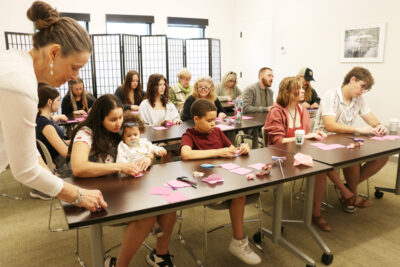Origami can be creative and meditative for enthusiasts
By Lethbridge Herald on May 16, 2025.
 Laurie Zienchuk assists during son Lev's origami class at the Nikka Yuko Japanese Garden's Bunke Centre Sunday.
Laurie Zienchuk assists during son Lev's origami class at the Nikka Yuko Japanese Garden's Bunke Centre Sunday.Joe Manio
Lethbridge Herald
Local Journalism Initiative Reporter
Visitors to the Nikka Yuko Japanese Gardens had an opportunity to learn origami, the art of paper folding, to create paper flowers, butterflies and even birds during the Mother’s Day – Haru Festival.
There was an all-day unstructured session inside the Pavilion within the gardens and a shorter structured class led by 17-year old instructor Lev Zienchuk and his mother Laurie at the Bunke Centre.
“Origami is a very inexpensive art to do, and finding quality paper to fold with is very easy,” says Zienchuck. “It’s a very precise art, but it’s so satisfying to both work on the project and complete it.
“As you get into more and more complex works, origami becomes a dance with the paper; each fold has a response to your crease. It can be a casual art as well as a serious art, and folders of all levels can enjoy it. You can fold origami pretty much anywhere on a flat surface.”
Origami has a rich history in Japan, though its roots may extend to China. While its exact origins are debated, it’s generally believed to have emerged in Japan after the 6th century, with paper introduced by Buddhist monks. Initially used for religious and ceremonial purposes by the wealthy and religious leaders, origami later became more widely accessible as paper became more affordable.
“The main thing that really inspired me to explore origami was Dr. Robert Lang’s TED Talk called ‘The Math and Magic of Origami,’” says Zienchuck. “I had folded origami casually before seeing this video, but Dr. Lang was the main catalyst of inspiration for me to explore this unique art. I had the privilege of meeting Dr. Lang in person when I attended the Pacific Coast Origami USA Convention in San Francisco in October 2023. What a great experience being able to fold in his classes! It was also amazing being around other folders passionate about origami, as I had never met another origami artist before then.”
Origami creations can vary from simple shapes like flowers, animals and geometric shapes that beginners can learn in an hour or less, to complex intricate projects which can take hours or days to finish. One of the samples Zienchuk had on display for his class was an intricate red dragon which he created from one large sheet of paper.
The term “origami” itself emerged in the late 1800s, evolving from “orikata” (folded shapes). A major figure in popularizing origami was Akira Yoshizawa, often called the “grandmaster,” who created a notation system and promoted the art worldwide in the mid-20th century.
In the present day, origami has found its way into therapy and personal-wellness uses.
Origami therapy can be a therapeutic practice used in various therapeutic settings, including art therapy, occupational therapy, and even mental health support. It’s a flexible and accessible technique that can promote mindfulness, improve fine motor skills, reduce stress, and enhance cognitive function.
“For therapy, it’s a beautiful medium to work with,” says Laurie Zienchuck. “I love the patterns of the paper and the texture of the different kinds of paper. I love the predictability of the folds and when I fold a 100 butterflies as a spring project for example, it’s meditative and calming.”
In addition to its intrinsic beauty as an art form, origami is very accessible. All that is needed is paper and a flat surface to get started; and beginners can use printer paper or even gift wrapping paper available at dollar stores. Anyone can learn origami through books which are widely available through bookstores and public libraries; through countless free instructional videos online; and through classes like those at Nikka Yuko, which are complementary with garden admission.
14-13


